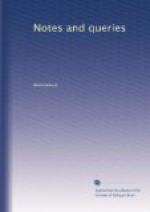W.W.
"Speak the Tongue that Shakspeare spoke."—Can you inform me of the author’s name who says,—
“They speak the tongue that Shakspeare
spoke,
The faith and morals hold that Milton
held,” &c.?
and was it applied to the early settlers of New England?
X.
Genealogical Queries.—Can any of your genealogical readers oblige me with replies to the following Queries?
1. To what family do the following arms belong? They are given in Blomfield’s Norfolk (ix. 413.) as impaled with the coat of William Donne, Esq., of Letheringsett, Norfolk, on his tomb in the church there. He died in 1684.
On a chevron engrailed, two
lioncels rampant, between as many
crescents.
Not having seen the stone, I cannot say whether Blomfield has blazoned it correctly; but it seems possible he may have meant to say,—
On a chevron engrailed, between
two crescents, as many lioncels
rampant.
2. Which Sir Philip Courtenay, of Powderham, was the father of Margaret Courtenay, who, in the fifteenth century, married Sir Robert Carey, Knt.? and who was her mother?
3. Where can I find a pedigree of the family of Robertson of Muirtown, said to be descended from John, second son of Alexander Robertson, of Strowan, by his second wife, Lady Elizabeth Stewart, daughter of John, Earl of Athol, brother of King James II.? which John is omitted in the pedigree of the Strowan family, in Burke’s Landed Gentry.
C.R.M.
Parson, the Staffordshire Giant.—Harwood, in a note to his edition of Erdeswick’s Staffordshire, p. 289., says,—
“This place [Westbromwich] gave birth to William Parsons, [query Walter,] the gigantic porter of King {136} James I., whose picture was at Whitehall; and a bas-relief of him, with Jeffry Hudson the dwarf, was fixed in the front of a house near the end of a bagnio court, Newgate-street, probably as a sign.”
Plot, in his Natural History of Staffordshire, gives some instances of the great strength of Parsons.
I shall feel much obliged if you or your readers will inform me, 1. Whether there is any mention of Parsons in contemporary, or other works? 2. Whether the portrait is in existence? if so, where? Has it been engraved?
C.H.B.
Westbromwich.
Unicorn in the Royal Arms.—When and why was the fabulous animal called the unicorn first used as a supporter for the royal arms of England?
E.C.
The Frog and the Crow of Ennow.—I should be glad to get an answer to the following Query from some one of your readers:—I remember some few old lines of a song I used to hear sung many years ago, and wish to learn anything as regards its date, authorship,—indeed, any particulars, and where I shall be likely to find it at length. What I remember is,—




